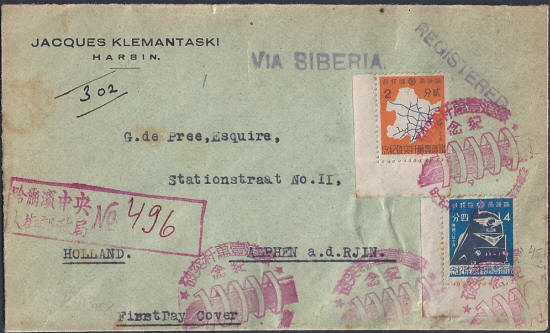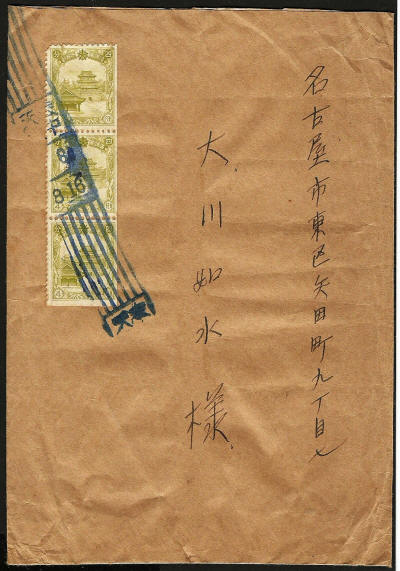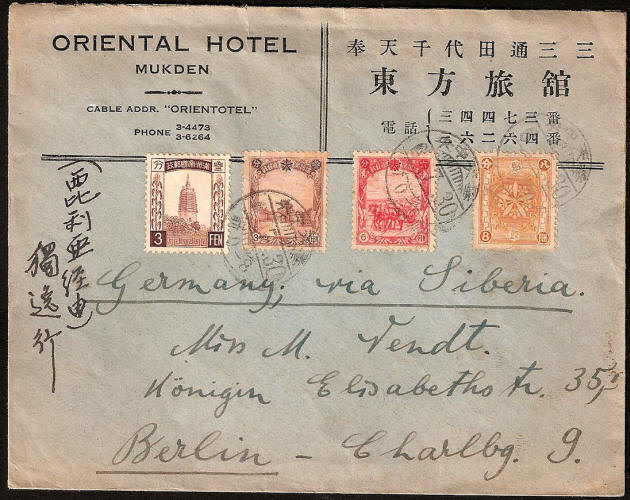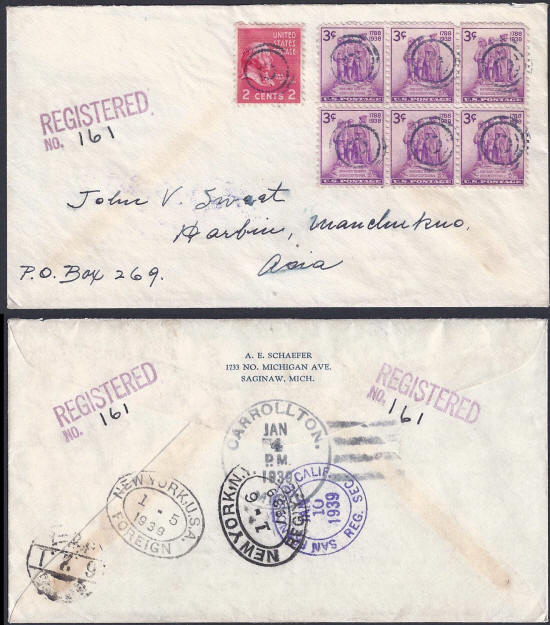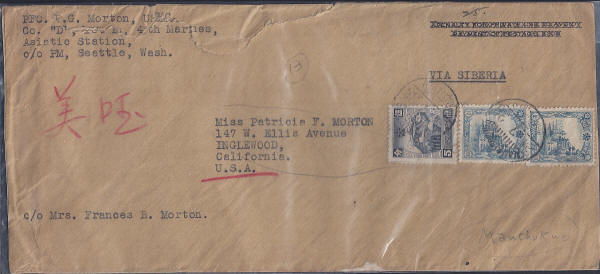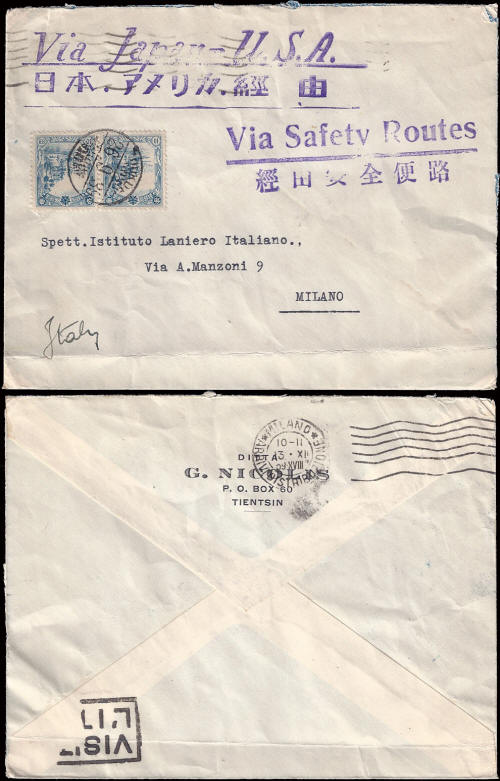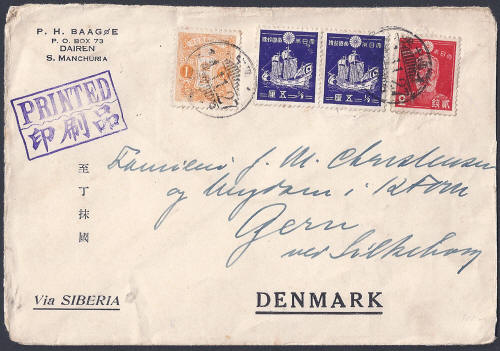 |
|||||
|
|
|
1939 Covers Manchukuo Year 6 康德 Kāngdé
|
|||
|
Registered Cover from Lung-ching-t'sun to Nagoya |
|||||
 |
|||||
|
This letter was posted from
Lung-ching-t'sun (Longjing), Kirin on 29th October 1939
to 名古屋市 Nagoya in Japan. The
sender, a Mr Okawa clearly requested the use of the scenic cancels
when he posted his letter from Longjing Post Office. Another
indication that the recipient may have been a stamp collector is the
use of the slogans appearing on the selvage attached to stamps from
the top row of the sheet. The envelope carries a native registration label number 183 and stamps (commemorative issue celebrating the completion of 10,000 km of railway track by the South Manchurian Railway) to the combined value of 12f - 4f letter rate to Japan plus 8f for registration. The postage is correct for this time. Improbable Dealer First Day Cover This is a first day cover sent to Holland by the stamp dealer Jaques Klemantaski. This cover would not have been sent through the normal postal system. The minimum letter rate was 12f and to add registration would be another 16f. There are no arrival marks on this cover and it was probably made for sale with the assistance of a friend at the post office who added the registration stamp and the no doubt, fictitious, registration number. Note that the actual post office name is not shown clearly on any of the four cancellations although the registration box is linked to 哈爾濱中央大街 Harbin Central Street Office. Most FDC's have incorrect postage rates ( they are posted in a larger envelopes with the correct stamps) but it is unusual to find the addition of a registration stamp. |
|||||
|
|
|||||
|
Roller Cancel and Booklet Stamp Cover |
|||||
|
This is an interesting cover that combines a roller cancel with the use of 3 x 4f booklet stamps, the entire right hand half of a booklet pane. The letter is addressed to Ōkawa, Japan and is postmarked with a Fengtian roller cancel. The value in stamps used means that the weight of the item was between 40g and 60g. This is three times that rate of a standard letter of 20g. |
|||||
|
|
|||||
| Printed Matter Cover to the USA | |||||
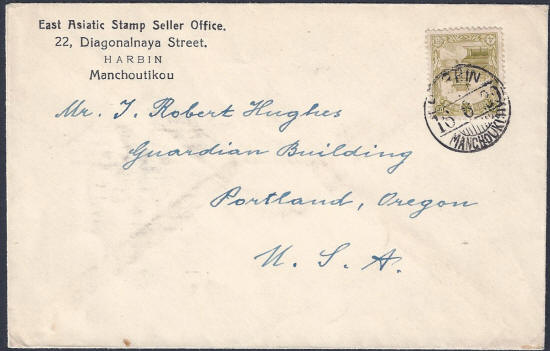 |
|||||
|
This cover was sent on 16th June 1939
from a stamp dealer in Harbin, The East Asiatic Stamp Seller Office
to J. Robert Hughes, a well knows stamp dealer in Portland, Oregon.
The cover has a Harbin international date-stamp and the 4f rate indicates printed matter, probably a trade pricelist. |
|||||
|
|
|||||
| Registered Cover To Vienna | |||||
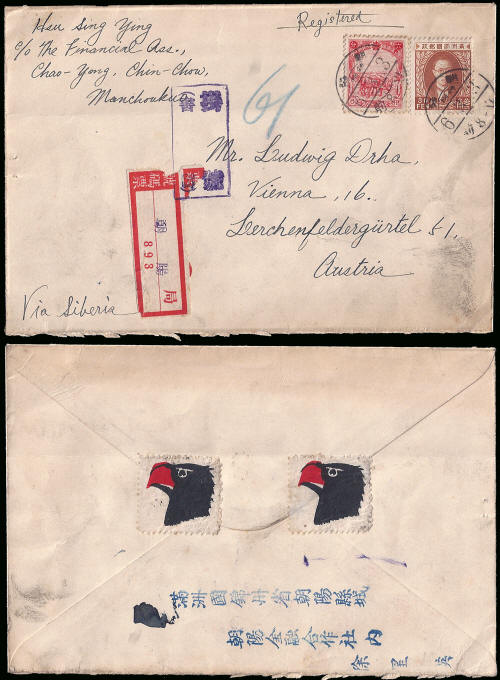 |
|||||
|
This cover was posted in
頦 縣
Chin-chou (Jinzhou) on 3rd March 1939 the destination
being Vienna in Austria. The cover has a Chin-chou registration
label (No 893) and a purple hand-stamp reading "Registered in
Chinese", a further hand-stamp in blue on the back of the envelope
contains the address of the sender. The cover is further
distinguished by two crudely printed labels each with an eagles
head, possibly an Austrian emblem. The postage is correct - 20f, the international letter rate + 16f for registration. |
|||||
|
|
|||||
|
Double Weight Registered Cover To New York |
|||||
|
This is a heavy, double walled wallet 280mm x 135mm sent from Harbin on 17th June 1939 to New York. The arrival date shown by the New York date stamps was 5th July 1939 a transit time of 19 days. The item if under 20g would have cost 20f the letter rate + 16f registration fee making a total of 36f. The stamps attached amount to 72f . The extra 36f is added due to extra weight 3 x 20g, each 20g would have cost an extra 12f at this time, meaning that the total letter would have weighed over 60g but less than 80g. The Yokohama Specie Bank fulfilled the role of the Central Bank in Manchukuo and the red seals are typical of covers sent by that organisation. It is also interesting to note that the stamps used have no perfins, YSB are known to have had a licence to use them but this item shows they did not always do so. |
|||||
|
|
|||||
| Registered Missionary Cover to Dairen | |||||
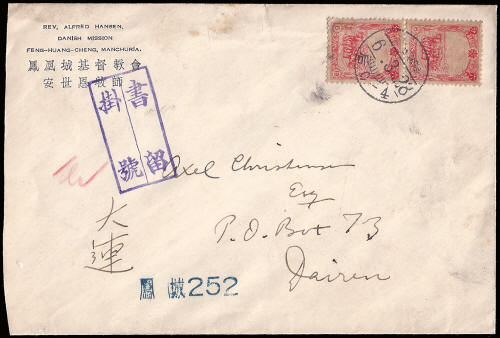 |
|||||
|
This registered cover was sent from the
Danish Mission in 鳳凰城
Feng-Huang-Ch'eng to Dairen on 28th
March 1939. The 12f postage rate is correct, 4f letter rate + 8f for
registration. Dairen qualified for the domestic postage rate at this
time, unlike other parts of the Kwantung Leased Territory. The postal markings are a violet box with characters for "registered" in both Chinese and Japanese plus the grey-blue registration mark 凰鳳252. The sender added the characters 大連 Dairen to assist the Post Office in directing the mail. |
|||||
|
|
|||||
| Received Damaged at Harbin | |||||
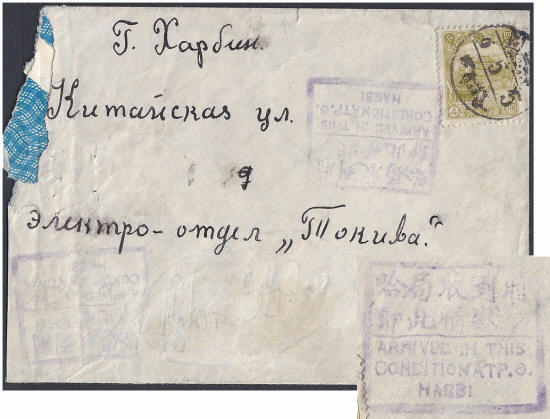 |
|||||
|
Most collectors avoid covers that look
torn or unduly distressed but in this instance this is the point.
This item of mail arrived at the Harbin Post Office damaged and
received a bi-lingual violet hand-stamp reading "ARRIVED
IN THIS CONDITION AT P.O. HARBI" for some reason the "N" is
missing from the end of Harbin. See a close-up
here. This explains the damage to the upper left hand
side of the envelope. The post mark is unreadable except for the date which is 6.5.5. (5th May 1939). 4f is the correct rate for a domestic letter sent from outside the city. The writing is Cyrillic Харби́н (top) is Harbin in Russian the rest of it reads "Chinese Street, Electro-Department TOKIVA". (This item was once part of the Robert W. Farquhar collection).
|
|||||
|
|
|||||
|
Special Postcard Packet Rate Packet from Manchukuo to Japan |
|||||
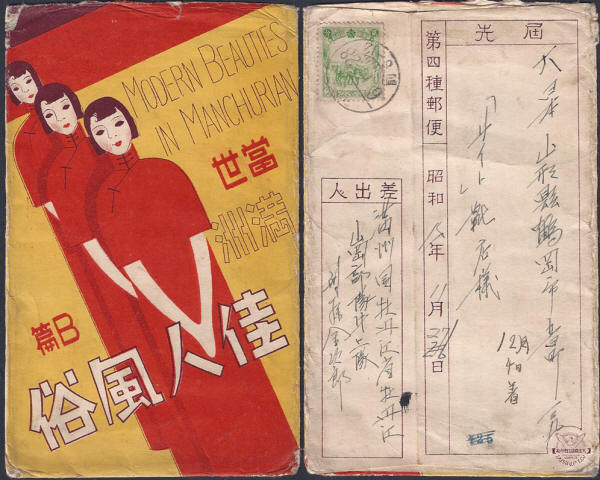 |
|||||
| This is further evidence that packets of postcards could travel at the rate of a single postcard, ie; as Class 2 postage. This tradition existed in Japan and similar examples have prompted me to include these items in the postage table. | |||||
|
|
|||||
|
Letter Rate Cover from Mukden to Germany |
|||||
|
This is a standard rate cover to Germany posted on 30th July 1939. The use of the Oriental Hotel stationary makes it an attractive item and lends context. The postmarks show this cover passed through the Mukden Central Post Office. Interestingly these are domestic postmarks instead of the normal International postmark reading "MUKDEN". This may have been an error. The postage rate is correct at 20f
|
|||||
|
|
|||||
| Mission Cover to the USA. | |||||
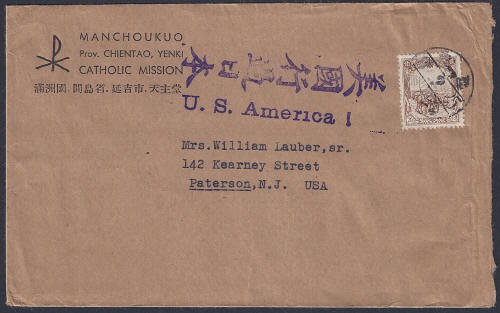 |
|||||
| This is a mission cover sent from Yenki to the USA. The domestic style cancel is dated 25th February 1939 and the postage of 20f was the correct rate for a letter of up to 20g at this time. | |||||
|
|
|||||
|
Incoming Mail from the USA to Harbin. |
|||||
| This is a letter posted to the writer and stamp dealer John V. Sweet in Harbin. The letter started it journey in Carrollton Michigan on 4th January 1939, it then went to New York for sorting where it was date-stamped on the 5th and 6th of January before being transferred by train to California on 10th January. From there it went by ship to Manchukuo via Japan and arrived in Harbin where an arrival date-stamp was added on 1st February 1939. A total transit time of 27 days (a little on the slow side). | |||||
|
|
|||||
| Stamp-less Official Cover - Undatable? | |||||
 |
|||||
|
This is a stamp-less cover used to send
official mail from Mukden Central Post Office.
The printed characters read
郵政公事 Post Office Official and below
奉天中央郵政局
Mukden Central Post Office. A printed card was also produced
in Mukden and a sample of this is shown at the end of the Postcards
section. The reverse of the cover is blank. The problem this cover poses is that, not having a stamp, it also lacks a postmark and this makes it hard to date. Certain clues exist however, we know for instance that it must date from later than Oct 1935, this is because before this the post office was simply Mukden Post Office, not Mukden Central Post Office. Now all that remains is to find date-stamped examples of covers where the red boxed "registered" hand-stamp appear with a similar registration hand-stamp in blue ink and the mystery of the date will be solved. I have not found such a cover yet so I have assigned the cover to this page until one turns up. |
|||||
|
|
|||||
| Registered Mail to China | |||||
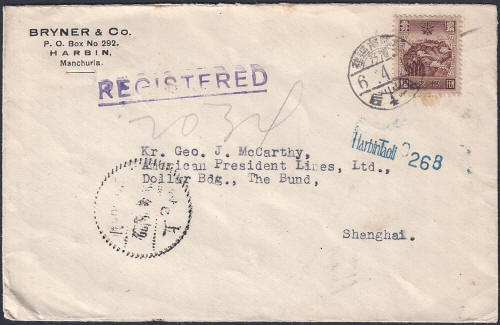 |
|||||
|
This cover was sent from Bryner & Co in
Harbin to George "Mac" McCarthy
a shipping agent in Shanghai. The letter was posted on 1st
April 1939 from 哈爾濱道裡 Harbin Taoli Post Office as shown by the
postmark and the registration hand-stamp
HarbinTaoli0268. Daoli is one of the oldest parts of Harbin
and Central Avenue, where this Post Office was situated, became the main
business district. The Shanghai arrival postmark is unclear but it
looks like the letter may have been delivered on 8th April, a
transit time of 8 days. The postage, in the form of a 1937 fourth issue 13f China Mail stamp is correct. The letter rate at this time was 5f with an additional 8f to cover registration, indeed this is the precise reason for which this stamp was created. |
|||||
|
|
|||||
| Harbin to Ohio Standard Postage Rate | |||||
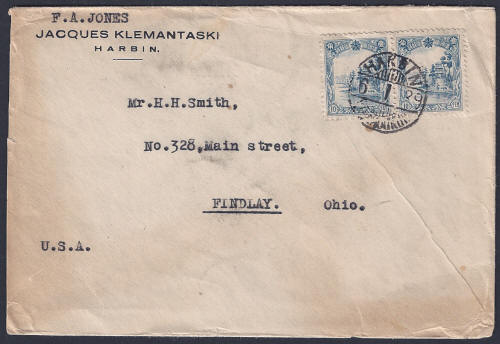 |
|||||
|
This cover was sent on 6th January 1939
by Mr F A Jones of Jacques Klemantaski, a stamp dealer in Harbin to
Mr H H Smith in Ohio.
Mr Smith was a collector
and from my researches I find that
in
1962, he created and
ran the "Fort Findlay Local Post". This is a standard rate international letter and the postage is correct at 20f. The letter has an International Harbin postmark and would have taken between 20 and 25 day to reach its destination.
|
|||||
|
US Navy Cover from Nan-sui-chung to Seattle This cover was sent from Nan-sui-Chung on 24th July 1939 by Private First Class Pete Morton, US Marine Corps to his sister Patricia in Inglewood, California, USA. The cover carries stamps to the value of 25f, this is incorrect, the postage rate was 20f at this time and it seems Private Morton overpaid by 5f. The cancels are indistinct but by enhancing them you are able to read NANSUICHUNG in the top segment of the international postmark. The red markings in Chinese represent an abbreviated 行美國 To America, you will see that USA is also underlined in same red pencil. The envelope used has the crossed out warning "PENALTY FOR PRIVATE USE TO AVOID PAYMENT OF POSTAGE $300". The US Asiatic Fleet had a base in Seattle, later the base was transferred to Pearl Harbour where only three years later it would be attacked by the Japanese.
|
|||||
|
Safety Routes Cover The only thing that is in any way remarkable about this cover is the route chosen by the sender. The "Via Safety Routes" hand-stamp probably stems from the Nomonhan Incident. On 11 May 1939, things quickly got out of hand when a contingent of Mongolian cavalry strayed over the disputed border to graze their horses and were attacked by a unit of Manchukoan cavalry. This escalated into a major conflict involving thousands troops, tanks and planes, which generally, the Mongolians and Soviets were winning. Fortunately for Japan, Russia agreed a ceasefire on 16 September 1939 so that it could concentrate its on firepower on the Nazis. The sender of this letter thought it unlikely that the Siberian route would be safe for mail at this time and directed it via Japan and the USA, in view of the close proximity of Nomonhan to Manchouli it seems likely that the Siberian mail route would have been suspended during this conflict. The Mukden International date-stamp shows that this cover was posted on 26th September 1939 and it arrived at its destination in Milan, Italy on 13th November 1939, a transit time of 48 days, far longer than would have have been the case had the cover been stamped "Via Siberia". From the "Via Japan-USA" hand-stamp the reason is clear, the cover had to travel around nearly 2/3 of the worlds circumference to reach its destination. Sent by the Siberian route the cover would have taken about 25 days to complete its journey. This is a standard rate international letter and the postage is correct at 20f.
Dairen to Denmark Printed Matter Cover This cover entered the post in Dairen on 27th November 1939 for delivery to Denmark. It is clearly marked PRINTED 印刷 品 (Printed Matter). The stamps total 4 sen, the correct rate for this period for a Printed Matter letter of less than 50g in weight. This is an example of the harmonisation of postal prices following the 1935 Postal Agreement with Manchukuo, the same postage rates apply in Japan, the KLT and Manchukuo.
|
|||||

